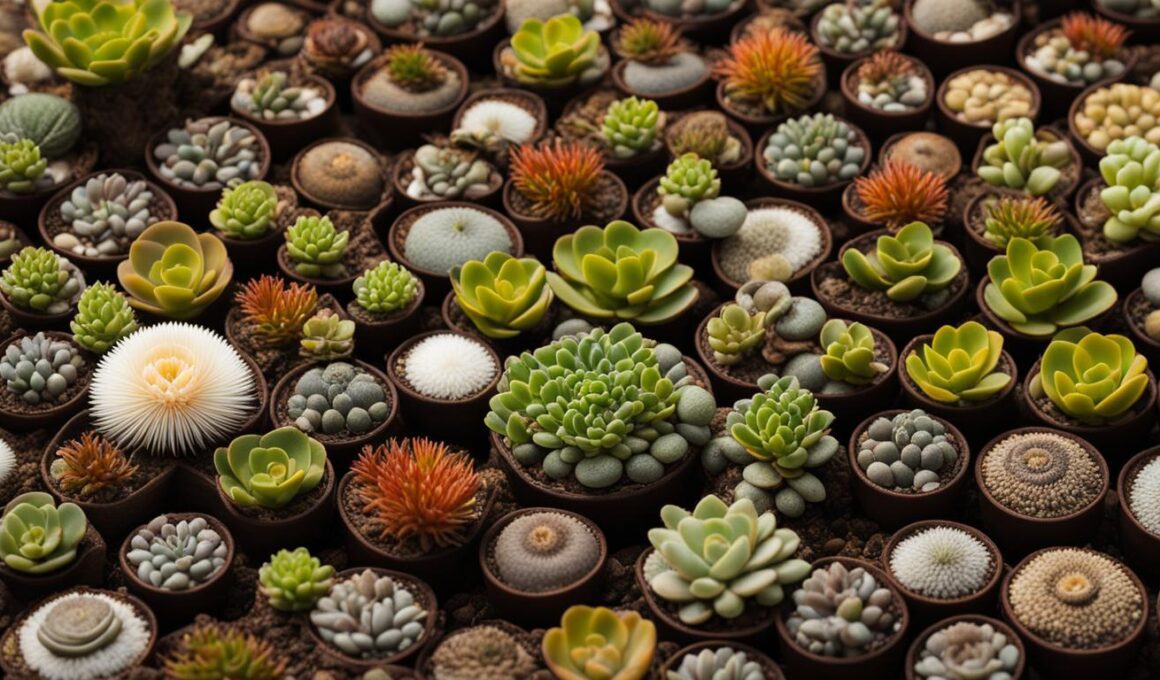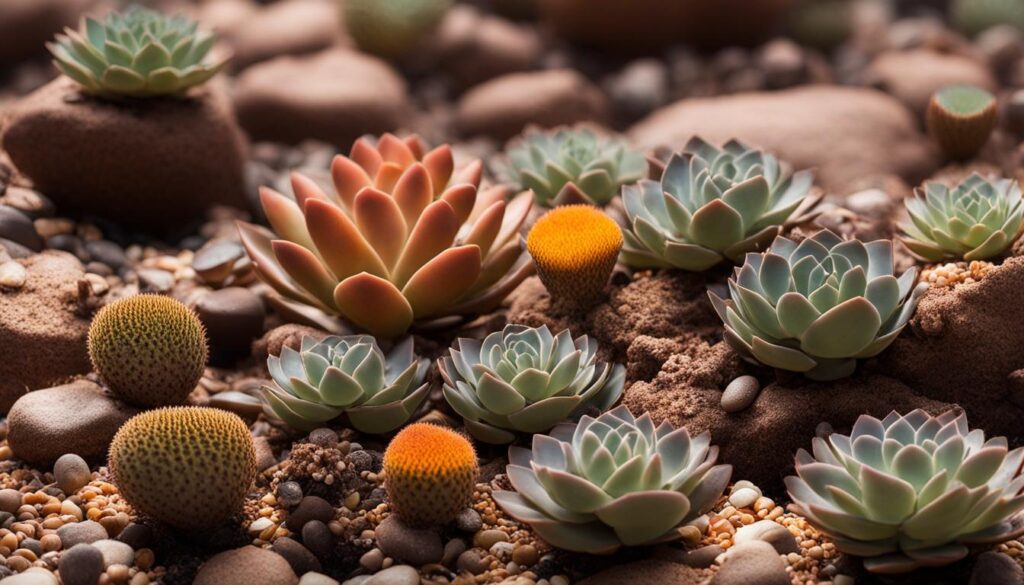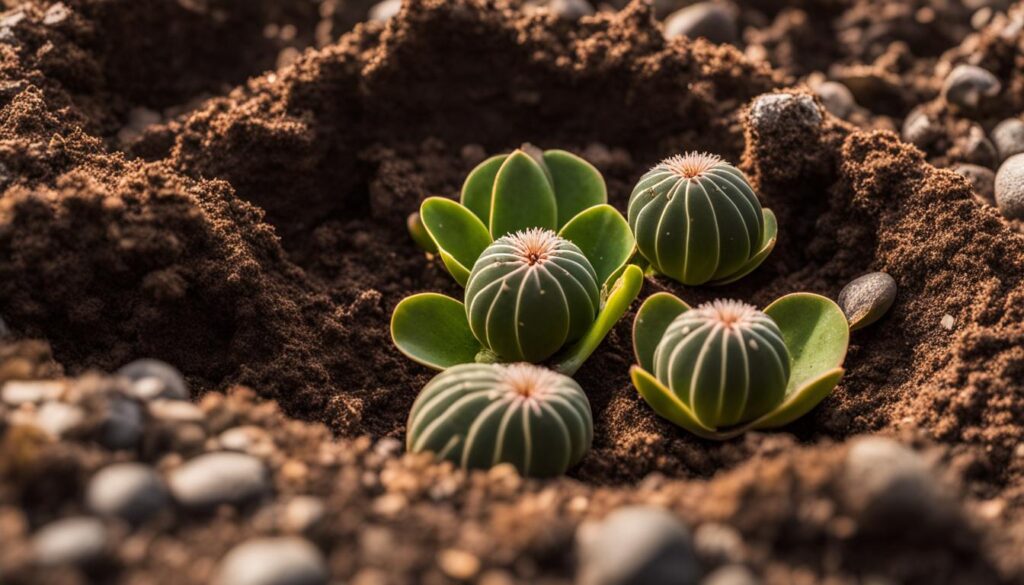Welcome to our comprehensive guide on understanding the growth cycle of Lithops, the small stone-like succulent plants native to southern Africa. In this article, we will delve into the various stages of their growth, their natural habitat, and cultivation tips to help you successfully nurture these fascinating plants.
Post Summary
- Lithops have a yearly cycle of growth, flowering, and dormancy.
- They thrive in arid regions with low rainfall and have evolved to blend in with their surroundings.
- Cultivating Lithops as houseplants requires low maintenance and proper watering techniques.
- Lithops have an annual growth cycle consisting of spring, summer, autumn, and winter.
- Recreating their natural habitat and providing bright light and well-drained soil is essential for successful cultivation.
Habitat and Natural Conditions of Lithops
Lithops, also known as “Living Stones,” are fascinating succulent plants that thrive in harsh arid regions with low rainfall. These unique plants are native to Namibia and South Africa, where they have adapted to diverse habitats such as quartz grit or gravely flats, stony ridges and hills, decomposed granite, and limestone. By blending in with their surroundings and resembling stones, sand, and soil, Lithops have evolved a natural camouflage that helps them survive in their native habitats.
The regions where Lithops are found generally receive less than 20 inches of rainfall per year, making them well-suited to thrive in arid conditions. Some Lithops species even rely on mist or fog as their primary source of moisture. This ability to adapt to low rainfall and make use of alternative water sources has contributed to their survival in harsh environments.
To successfully cultivate Lithops as houseplants, it is important to recreate their natural habitat as closely as possible. This means providing them with well-drained cactus potting mix, placing them in a sunny and dry spot with good airflow, and avoiding overwatering. By understanding their habitat and natural conditions, you can create an environment that allows Lithops to flourish and showcase their unique beauty.
| Habitat | Natural Conditions |
|---|---|
| Quartz grit or gravely flats | Low rainfall, dry conditions |
| Stony ridges and hills | Minimal moisture, arid environment |
| Decomposed granite | Poor soil, low water retention |
| Limestone | Dry climate, well-drained soil |
Cultivation of Lithops as Houseplants
Lithops make excellent houseplants due to their low-maintenance nature and unique appearance. With proper care, these fascinating succulents can thrive indoors and bring a touch of nature to any living space. Here are some tips for successfully cultivating Lithops as houseplants:
Low Maintenance Care
Lithops are known for their ability to survive in arid conditions, making them ideal for those who prefer low-maintenance plants. They require minimal watering and can withstand periods of drought. To keep your Lithops healthy, water sparingly and allow the soil to dry out completely between waterings. Overwatering is the most common cause of plant death, so it’s important to avoid waterlogged soil.
Watering Tips: During the active growth and flowering stage, water your Lithops lightly, allowing the soil to dry slightly before the next watering. However, during their dormancy period, which usually occurs in winter, it’s best to withhold water completely. This mimics their natural habitat, where they would experience little to no rainfall.
Proper Lighting
Lithops require bright, indirect light to thrive. Place them near a sunny window or in a well-lit area, but be cautious of placing them in direct sunlight, as this can cause the leaves to burn. Aim for at least six hours of bright, indirect light per day to ensure healthy growth.
Well-Drained Soil
To prevent waterlogging and root rot, it’s crucial to use a well-drained soil mix when planting Lithops. A cactus potting mix or a blend of sandy soil and perlite works well. This type of soil allows excess water to drain away quickly, preventing moisture-related issues.
Nutrient Requirements: Lithops are adapted to growing in nutrient-poor soils, so they do not require regular fertilizer. Applying a diluted, low-nitrogen fertilizer once or twice a year during the active growth stage can provide a boost, but be careful not to over-fertilize.
Lithops have a fascinating annual growth cycle consisting of four distinct stages: spring, summer, autumn, and winter. Each season plays a crucial role in the development and survival of these unique succulent plants.
Spring
In spring, as the temperatures begin to rise, Lithops start their growth cycle by producing new leaves. These new leaves emerge from the fissure between the old leaves, gradually replacing them. It is an exciting time as the plant prepares for its active growth phase.
Summer and Early Fall
During the summer and early fall, Lithops enter a period of active growth and flowering. The plant receives ample sunlight and warmth, which stimulates photosynthesis and the production of energy. It is during this time that Lithops produce their stunning daisy-like flowers, adding a burst of color to their surroundings.
Autumn and Winter Dormancy
As autumn approaches, Lithops transition into a period of dormancy to conserve energy and survive the harsh conditions of winter. The plant’s growth slows down significantly during this time, and the focus shifts to storing and conserving water. The old leaves begin to wither, allowing the new leaves to fully develop and take their place.
It is essential to note that watering should be stopped during the dormancy period. This allows the old leaves to dry out completely and prevents the risk of overwatering, which can be detrimental to the plant’s health. Once the old leaves have dried, watering can be resumed in preparation for the next cycle in spring.
Understanding the annual growth cycle of Lithops is crucial for successfully cultivating and caring for these unique succulents. By providing the right conditions and following the specific watering schedule, you can ensure the continued health and vitality of your Lithops plants, allowing them to thrive year after year.
Cultivation Tips for Growing Lithops
When it comes to cultivating Lithops, creating an environment that mimics their natural habitat is key. These unique succulents thrive in strong light but should be protected from direct sun. To ensure optimal growth, place your Lithops in a well-drained cactus compost and position them in a sunny, dry spot such as a south- or east-facing windowsill.
Propagation of Lithops can be done through division or from seeds, but both methods require time and patience. If you choose to divide your Lithops, be sure to carefully separate the clumps without damaging the roots. Seeds can be sown in a well-draining soil mix and should be kept slightly moist until germination occurs. Be prepared for a slow germination process, as it can take anywhere from a few weeks to a few months for the seeds to sprout.
Watering is a crucial factor in successfully growing Lithops. These plants are adapted to arid conditions, so it’s important to water sparingly and follow a specific watering schedule based on their growth cycle. Overwatering is a common mistake that can lead to root rot and plant death. During the active growth and flowering stages, it’s best to water Lithops when the soil has completely dried out. However, during dormancy, which typically occurs during winter, it’s best to avoid watering altogether. This allows the old leaves to wither and the new leaves to fully develop.
| Growth Stage | Watering Frequency | Watering quantity |
|---|---|---|
| Active growth and flowering | When soil is completely dry | Light watering, moistening the soil |
| Dormancy | Avoid watering | No watering |
Conclusion
Understanding the Lithops growth cycle is crucial for successfully nurturing these fascinating plants. By mimicking their natural habitat and following their specific watering schedule, you can ensure the health and longevity of your Lithops as houseplants. Their low-maintenance nature and ability to store water make them ideal for indoor cultivation.
Remember to provide your Lithops with bright light, well-drained soil, and proper watering. They thrive in low humidity and need infrequent watering, so be sure to avoid overwatering, as this can lead to their demise. Following their annual growth cycle, including the period of dormancy during winter, is essential to their overall health and well-being.
With the right care and attention, your Lithops can live for many years, rewarding you with their unique growth cycle and beautiful daisy-like flowers. Enjoy the experience of nurturing these stone-like succulents, and witness the wonder of their growth and transformation as they thrive in your home.
FAQ
How often should I water my Lithops?
Lithops should be watered sparingly, allowing the soil to dry out completely between waterings. During certain stages of their growth cycle, such as dormancy, watering should be avoided altogether.
What kind of soil should I use for my Lithops?
Lithops require a well-drained planting medium, such as cactus potting mix, to prevent waterlogging.
How long does the Lithops growth cycle last?
The Lithops growth cycle consists of four stages: spring, summer, autumn, and winter. This cycle repeats each year.
Where should I place my Lithops for optimal growth?
Lithops prefer strong light but not direct sun. They should be placed in a sunny, dry spot such as a south- or east-facing windowsill.
How can I propagate my Lithops?
Lithops can be propagated through division or seed, but both methods require time and patience.
Can Lithops survive indoors as houseplants?
Yes, Lithops are popular houseplants due to their low-maintenance nature. They can thrive indoors as long as they are provided with bright light, well-drained soil, and proper watering.
How Does the Lithops Growth Cycle Affect its Flowering Season?
The lithops flowering season guide is determined by the unique growth cycle of these fascinating plants. Lithops go through a dormant period in the summer, followed by new growth and flowering in the fall. Understanding this cycle is crucial for ensuring a successful and vibrant flowering season for your lithops.











